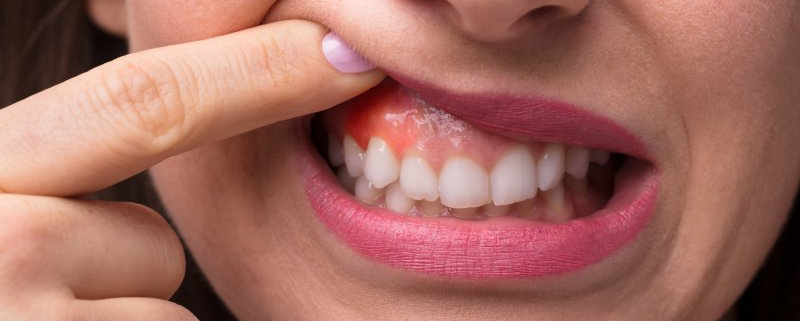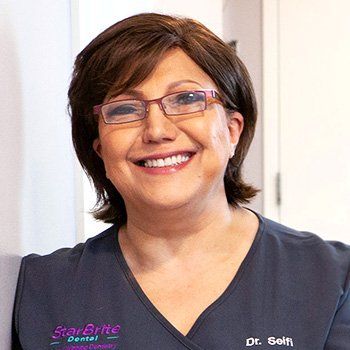Swollen Gum Behind Molar - Causes, Treatment and Prevention

If you suffer from a swollen gum behind your molars, you should consult with our office right away. Fortunately, in most cases, the cause is simple and does not indicate that anything is seriously wrong. However, it is vital to catch those cases that are about to create serious problems and eliminate the cause.
The gum behind the molar can
become swollen due to a number of reasons, including infection, inflammation, or trauma. The gum area right behind a wisdom tooth typically becomes inflamed when the wisdom tooth is not able to erupt properly into its right position. The wisdom tooth may partially erupt, meaning that it begins to take its place in the jaw, but then becomes jammed. A tooth that cannot fully erupt is likely to be fully or partly covered with gum tissue.
This gum coverage over a partially erupted tooth typically results in a somewhat loose gum flap completely or partially covering the tooth. Food debris can work its way under this flap of tissue. Once there, this debris can introduce bacteria into the covered area. The bacteria have now found a perfect area in which they can thrive. It is not even possible to wash the bacteria out with your routine dental hygiene, in part because this area in the back of the mouth is so hard to reach. An infection can get started that causes symptoms of
pericoronitis, the name for this problem of swollen gums behind molars.
Symptoms of Pericoronitis
For some people, pericoronitis lasts only a short time—perhaps three or four days. Symptoms of this acute pericoronitis include:
- There’s an infection and swelling in the gum flap.
- A bad taste is perceived in the mouth.
- Pus discharge may be seen.
- The swelling may be on one or both sides.
- The swelling can also show up in the cheeks.
- Some of the lymph nodes are swollen.
- There is a fever and possibly chills.
These symptoms could last three or four days and then subside. Or, if they are not examined and treated, they could turn into chronic pericoronitis. At this point, the infection can spread to other areas.
Chronic pericoronitis will be
accompanied by bad breath, a dull ache in the area of the swollen gum and continued swelling in the lymph nodes. A spread of infection to the throat can make it difficult to swallow. It can hurt to bite down, especially on the side where there is a swollen gum.
Acute or chronic pericoronitis can occur around any number of teeth. It will usually appear around either one or two teeth, and normally in the lower jaw.
Treatment for Swollen Gum Behind Third Molars
The treatment will, of course, vary by the situation your dentist finds after a
careful examination and x-rays, especially when they are dealing with wisdom teeth swelling. Pericoronitis usually occurs where the two lower wisdom teeth are trying to find space to erupt. Many people do not have enough room in their jaws for these teeth to come in normally. A wisdom tooth may come in crooked and then get jammed. Or it may not come in at all. Still, the gum flap may cover part or all of the teeth.
If the x-ray shows that the tooth will be able to erupt, then all that might need to happen is the
surgical removal of the flap. A round of antibiotics can eliminate any infections.
In most cases, this partially erupted wisdom tooth does not have enough room behind the second molar tooth to fully erupt. It will need to be extracted to fully resolve the problem. This is the only way to resolve impacted wisdom teeth, swelling gums and infections.
A Look at Our Wisdom Teeth
The average adult person will have 32 teeth when all their teeth have come in. First to arrive are the baby teeth, followed at intervals with permanent teeth. These teeth show up like this:
- The first teeth come in between 6 and 12 months of age
- The next few teeth appear between 9 and 16 months
- By the time the child is three years of age, baby teeth through the second molars have arrived.
- Between seven years of age and 13, all these teeth are replaced with permanent teeth.
- The third molars—the wisdom teeth—generally erupt between 17 years of age and 21.
These teeth all the way in the back are the hardest to keep clean so they are the most
likely to develop cavities.
The plaque that develops on teeth when they are not kept clean
can harden into tartar or calculus and that can
lead to dental decay. This hard-to-clean zone can also suffer infections and swelling in the gums around these four molars.
A few people are lucky to escape this problem because behind the last molar, no wisdom teeth come in. This is very rare, though.
Frequently Asked Questions About Swollen Gums Behind the Second Molar
This is not a topic that many people are familiar with until it happens to them or their child. Therefore, we get many questions from our patients who want advice about swollen gums behind the molars. Check out answers to our most frequently asked questions.
Who is most likely to experience swollen gums behind a molar? In other words, what are the risk factors for developing swollen gum behind a molar?
The primary reason this problem exists is because of a partially erupted wisdom tooth. However, there are other factors that increase the risk, meaning that a person can have a partially erupted wisdom tooth and not experience pericoronitis unless these other conditions exist. These other factors are:
- Poor oral health
- Excess gum tissue in the jaw
- Respiratory tract infection just before experiencing pericoronitis
- Pregnancy
- Higher-than usual stress
- Fatigue
- Age in the 20s
One of these factors that can be controlled is oral health. Practicing
good oral hygiene is vital for so many reasons. When a
good at-home hygiene regimen is practiced and combined with regular visits to a dentist, then gum health can be protected. Problems like tooth decay, tooth abscess or
gingivitis or periodontal disease leading to
receding gums can be avoided. And the risk of pericoronitis can also be reduced.
What is the cause of the swollen gum behind a molar?
While puffy gums throughout the mouth indicate gingivitis or early gum disease, gum pain all the way in the back of the mouth is often associated with pericoronitis. The real problem may be what is happening behind the swelling. The flap covering the wisdom tooth can harbor bacteria and food debris which is the perfect place for infection to start. If it is caught early, this could be a simple problem to address, or resolving it could require the extraction of the wisdom tooth.
Another cause of pericoronitis is when the third molar
becomes an abscessed tooth. In this case, the infection from the tooth spreads to the gum. This is why it is vital to visit our offices as soon as you notice swelling around the third molar. A careful diagnosis is an important first step.
What are the complications associated with the swollen gum?
The swollen gum results from a gum inflammation that is usually caused by a bacterial infection. Analysis of pericoronitis cases proved that there can be dozens of different bacteria involved in any individual situation of inflamed gums. The most common one is the ubiquitous bacterial family Streptococcus. An infection like this can affect the area around one tooth or many teeth.
On rare occasions, this bacteria or any other present in these infections can spread to other parts of the body. A condition known as
Ludwig’s angina can occur when this infection spreads into the neck and head. If the bacteria spread into the bloodstream, it can turn into a life-threatening condition known as
sepsis. For this reason, pericoronitis should be addressed promptly.
An abscess can occur in gums swollen from pericoronitis—another reason rapid treatment is necessary. If the wisdom tooth involved in the problem does not need to be
extracted, removal of the gum flap with brief oral surgery and antibiotics may be all the resolution needed.
What are the possible treatments for the swollen gum?
Warm salt water wash can remove food debris and provide temporary relief. Minor oral surgery, removal of the soft tissue growth over the tooth, can alleviate the immediate problem and prevent reinfection. This oral surgery can be done with local anesthesia. However, to fully resolve problems in this area, it’s going to be necessary to determine if the jaw bone has enough room to permit normal eruption of the third molar. This will require x-rays to determine the position and angle of the wisdom tooth.
All too often, the wisdom tooth is coming in at an angle. In some cases, the tooth can be positioned horizontally instead of vertically like the other teeth. This tooth will never be able to erupt through the gum. Surgical extraction will be needed which could require removal of part of the jawbone. It is worth fully addressing what might seem like a minor problem because of the possible complications of leaving it untreated. We know that it’s important to determine what’s behind swellings, wherever they occur.
Additional treatments for simple pericoronitis can include warm salt water rinses and antibiotics.
Who can treat swollen gums behind a molar?
Part of the treatment of swollen gums involves taking x-rays of the area to determine if partially-erupted wisdom teeth are causing this problem. If they are, one or more wisdom teeth may need to be extracted. This means that swollen gums behind the molar should always be referred to your dentist for complete dental treatment. It is important to select an expert and experienced dentist like the ones caring for you at StarBrite Dental as this experience can prevent the need for further and unnecessary treatment of the surrounding teeth.
How can pericoronitis be identified?
A dental hygienist will very commonly be the first to notice when acute pericoronitis has occurred because some of the signs are visible. Depending on your situation and the structures of your jaw, your usual general dentist may be able to fully treat your problem. In many cases, you will need an oral surgeon or an oral and maxillofacial surgeon. A medical doctor who identifies this problem should refer the patient to a dentist or an oral surgeon. If you are identifying this issue on your own, you should look for gum swelling, pain around the molar teeth gums or problems near the back tooth that make it difficult to open your jaw all the way. You might notice that some of your lymph glands are swollen and that it hurts to fully open your mouth.
Can pericoronitis be prevented?
To a certain degree, you can reduce your chances of pericoronitis by keeping your dental health good and treating periodontitis (advanced gum disease) as soon as it is identified. You can also address some of the risk factors listed above, when possible, to reduce your chances of experiencing this problem. For example, dealing with any external sources of stress as soon as possible will help protect your health, along with making sure you are well-rested.
Home Care for Pericoronitis
The best thing you can do for pericoronitis is call us
at StarBrite Dental as soon as you notice a problem. We can advise you on any home remedies that might help. If you are away from home and can’t get to our office, you may be able to improve the condition with a warm salt water wash or an antibiotic oral rinse. It is important to get the right medical treatments as soon as possible which could include medications to reduce the inflammation and infection.
At StarBrite Dental, providing emergency care for our patients is very important to us. When you notice a problem like this, call us and we will schedule you as soon as possible. We want to alleviate the infection and make you more comfortable immediately. Then we can inform you of any further treatment you need to eliminate the causes of this problem.
Please call us whenever you notice signs like a sore area,
gums swelling or bleeding in the gums. We will apply the extensive training and experience of our dentists to providing a complete resolution. You can reach us at (301) 770-1070. We are ready to help.
301-888-5785
301-889-9291 | 301-889-8366 | 301-756-5406
Our website is presented strictly for informational purposes. Nothing here is intended to be a substitute for professional medical advice or for the diagnosis or treatment of a medical condition.
If you have questions about your health you should seek the advice of a qualified health professional. Do not delay or disregard professional advice because of something you may read here.
All Rights Reserved | StarBrite Dental, the Office of Dr. Maryam Seifi
Website designed and maintained by Xpress, INC


